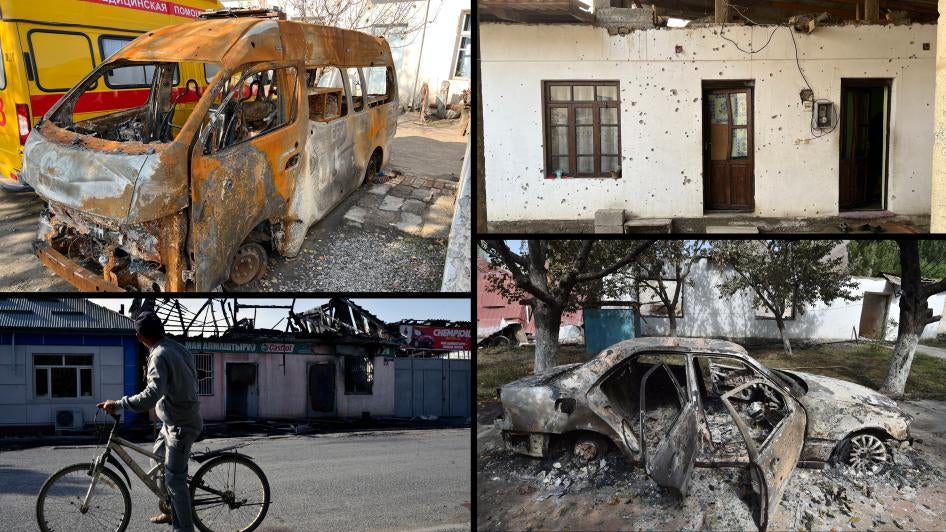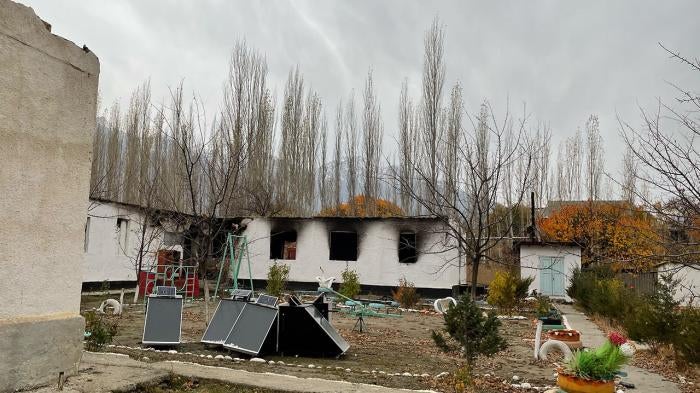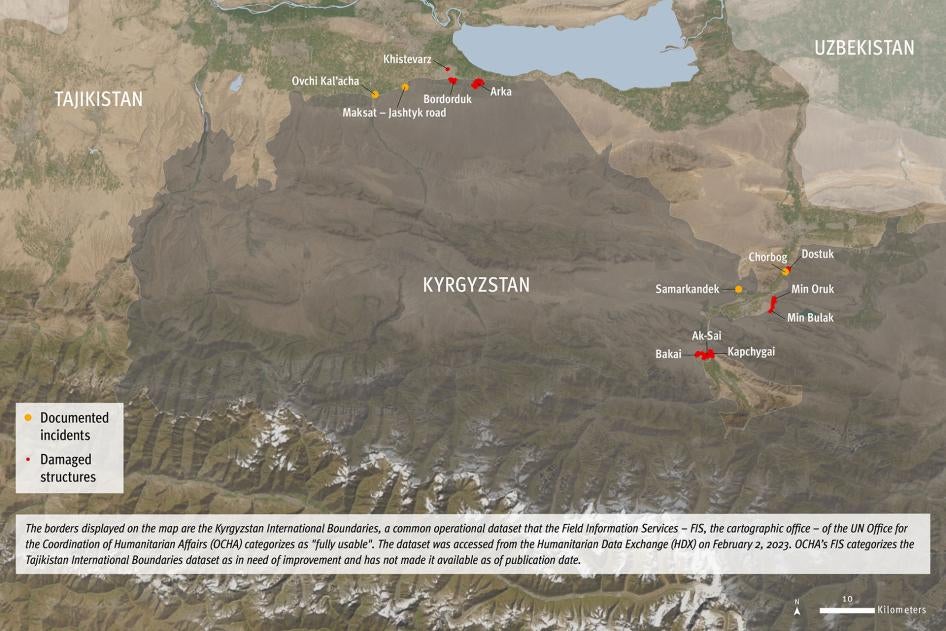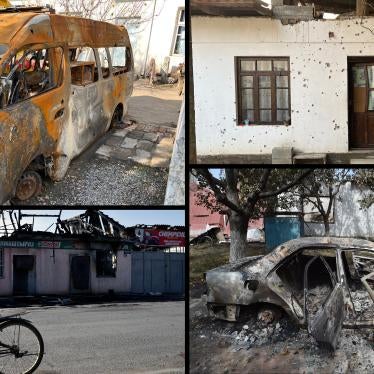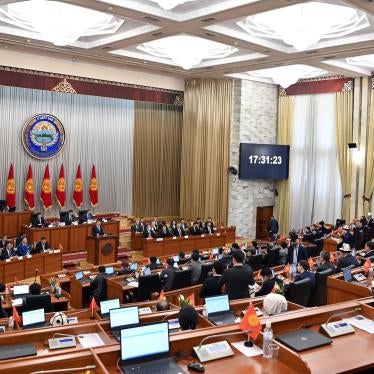- Forces from both Kyrgyzstan and Tajikistan killed and injured civilians in apparent war crimes during their brief but intense armed border conflict in September 2022.
- The families of victims deserve justice and reparations to pave the way for a rights-respecting resolution to this ongoing dispute.
- The two countries should promptly investigate the violations by their forces, hold those responsible to account, and provide redress. International partners should provide support.
(Berlin, May 2, 2023) – Forces from both Kyrgyzstan and Tajikistan committed apparent war crimes in attacks on civilians during their brief but intense armed border conflict in September 2022, Human Rights Watch said in a report released today.
The 69-page report, “‘When We Moved, They Shot’: Laws of War Violations in the September 2022 Kyrgyzstan – Tajikistan Border Conflict,” is the most detailed human rights account to date of the 4 days of fighting in 2022, from September 14 to 17. Kyrgyz forces shot at ambulances and cars carrying civilians and, in 1 incident, killed at least 10 civilians in a laser-guided bomb attack on a town square. Tajik forces shot at cars carrying civilians, unlawfully killed at least eight civilians in various circumstances, and allowed the large-scale looting and burning of private property in Kyrgyz villages.
“Civilians living in the disputed border areas of Kyrgyzstan and Tajikistan paid a heavy price for the callous conduct of both Kyrgyz and Tajik forces during the fighting last September,” said Jean-Baptiste Gallopin, senior crisis and conflict researcher at Human Rights Watch. “The families of victims deserve justice and reparations to pave the way for a rights-respecting resolution to this ongoing dispute.”
Human Rights Watch’s focus in this work is on violations of international humanitarian law, or the laws of war. The organization does not take a position on which side started the conflict.
In late October and early November, Human Rights Watch interviewed 86 people on both sides of the border, including 69 survivors, witnesses, or relatives of victims. Researchers visited the affected villages, examined munition remnants, verified 12 videos, analyzed satellite imagery, and constructed 3D models of attacks.
Human Rights Watch also submitted a series of questions to the governments of Kyrgyzstan and Tajikistan in December 2022 and March 2023. The government of Kyrgyzstan replied with information about attacks against its citizens but gave no information on attacks involving its own forces. The Tajik government did not respond to Human Rights Watch’s letters.
In total, Human Rights Watch documented the death of 37 civilians, including 5 children, and injuries to 36 others on both sides. Media reports and official victim lists indicate that the total number may reach 51 civilians killed and 121 injured. An estimated 130,000 people were reportedly displaced in Kyrgyzstan alone, and as of January 2023, at least 4,000 had yet to return to their homes.
Tensions between Kyrgyzstan and Tajikistan erupted into armed conflict on September 14, and spread along a roughly 110-kilometer stretch of disputed border in and around the fertile Fergana valley. The region contains critical choke points along rivers that provide strategic water resources to Batken – the district capital city on the Kyrgyzstan side – and to large swathes of irrigated farmland in Tajikistan.
The border was never fully demarcated after the two countries’ independence in 1991 and has periodically been the site of small-scale clashes. In clashes in April 2021, the countries’ border guards were involved.
In September 2022, the countries deployed their forces who fought with artillery, tanks, and other armored vehicles, and on Kyrgyzstan’s side, armed drones. Since September, the governments have engaged in renewed talks to delineate disputed areas of the border but have yet to reach an agreement.
Most violations occurred on the third day of the armed conflict, September 16. In one of the deadliest incidents, Kyrgyz forces dropped a laser-guided bomb with blast fragmentation effects on the central square in Ovchi Kal’acha, a Tajik border town, killing at least 10 people, mostly men who had gathered outside a mosque after a funeral. At least 13 other civilians were wounded in this disproportionate and apparently indiscriminate attack.
A 40-year-old woman who witnessed the attack said she heard a whistling sound before the square filled with smoke. “People were flying,” she said. “I remember the voices of people shouting. A lot of blood.”
On several roads along the border, Tajik forces that day attacked cars carrying fleeing Kyrgyz civilians, killing two civilian men, and injuring at least four other people. A 63-year-old woman whose husband and son were injured said her family crawled out of their car “to avoid being killed in it if it exploded” after Tajik soldiers shot at them. The family lay still on the ground for hours and, when they moved, Tajik soldiers opened fire again.
Earlier that day, two Tajik ambulances, clearly marked as such, and a civilian car came under heavy gunfire on a bridge near the border in Chorbog (Tajikistan), killing 10 civilians. Ambulances used for medical transport receive particular protection under international humanitarian law.
As the day progressed, Tajik forces overran Kyrgyz forces, killing at least six civilian men, including three while they were apparently fleeing, and two in apparent extrajudicial executions. People in civilian clothes and speaking Tajik looted private property under the watch of Tajik forces, while hundreds of homes and other types of civilian infrastructure, such as kindergartens, schools, medical facilities, and official buildings, were set on fire in an apparent attempt to clear the area of its population. Several villages were destroyed or burned down.
International humanitarian law, which applies to all parties to an international armed conflict, requires parties to distinguish between civilians and combatants at all times. It prohibits attacks that target civilians or attacks that are indiscriminate or expected to cause harm to civilians and civilian objects that are disproportionate to the direct and concrete military advantage anticipated. Warring parties must take all feasible precautions to avoid or minimize civilian harm.
The governments of Tajikistan and Kyrgyzstan should investigate potential violations or abuses by their forces and civilians in the areas they controlled and hold those responsible to account. The two governments should ensure that any border demarcation agreements and interim border arrangements respect the rights of local populations, including property rights, and access to education, adequate housing, and water.
They should also train their military and security forces in international humanitarian law and ensure its standards are upheld in future conflicts. They should promote confidence-building measures between local communities in border areas, including programs to reduce tensions and hate speech. Both governments should endorse the Safe Schools Declaration and the Political Declaration on the Use of Explosive Weapons in Populated Areas.
Kyrgyzstan and Tajikistan’s international partners should support steps by the two governments to investigate serious violations of international humanitarian law in the September 2022 border conflict and ensure accountability.
“On both sides of the border, civilians said they desperately want the cycle of conflict and abuse to end,” Gallopin said. “To help ensure a peaceful resolution, both governments should commit to protecting civilians and respecting human rights.”
The letter sent by the Kyrgyz Ministry of Foreign Affairs has been updated at their request, to reflect the current position of the Kyrgyz authorities.
